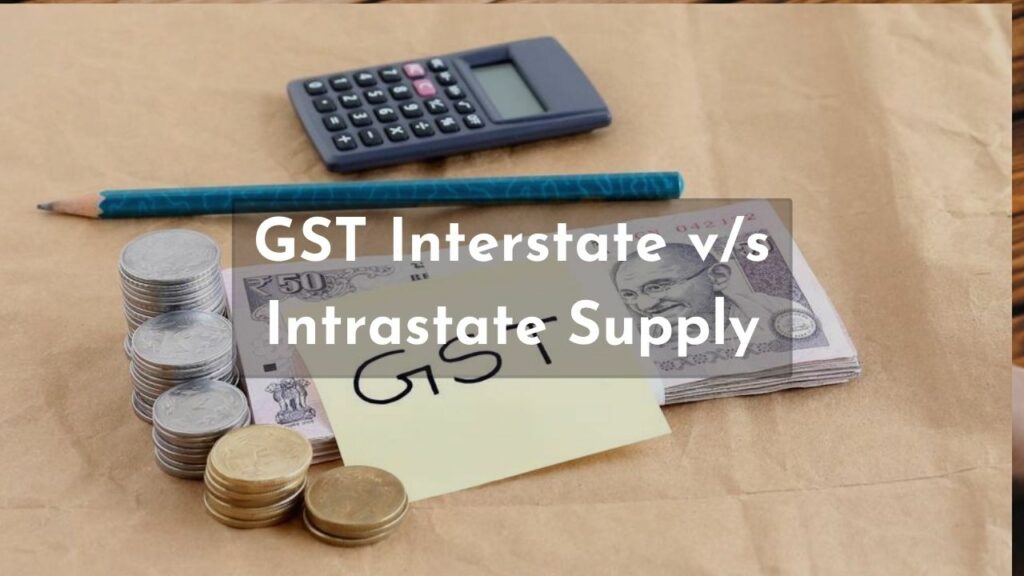GST Interstate v/s Intrastate Supply
The terms interstate and intrastate are crucial in determining the (Integrated Goods and Services Tax) IGST, (Central Goods and Services Tax) CGST, or (State Goods and Services Tax) SGST in GST (good service tax).

The (Integrated Goods and Services Tax) IGST applies to interstate deliveries, whereas the (Central Goods and Services Tax) CGST and the (State Goods and Services Tax) SGST apply to intrastate supplies. We shall look at the GST Act’s definitions of interstate supply and intrastate supply throughout this book.
What is Interstate Supply?
Under GST, interstate supply refers to the provision of goods or services from one state to another. The GST Act defines interstate supply as the location of the supplier’s and the customer’s matters:
• Two different States; or
• Two different Union territories; or
• State and a Union territory.
The availability of items imported into India till they pass through customs is also classed as interstate supply. Under the interstate supply, only the IGST must be paid, not the CGST or SGST. The GST interstate includes SEZ supplies as well (Special Economic Zone). The Integrated GST (IGST) will be levied on every taxable supply of goods and services made across states. It might even be justified by the same price or value. Section 15 of the CGST Law was used to calculate the tax.
You Can Also Click Here To Get Your GST Registration Today.
Point To Recollect For Inter-State Supply
- As per the GST Act, inter stat supply means the transportation of products or services between the state and union territory.
- Before they reach the customs station, products delivered to India are frequently brought up as an Inter-State Supply.
- Inter-State Supplies are the transportation of products and services from or to an exclusive economic zone or a selected development zone.
What is Intrastate Supply?
Inter-state supply is when the provider and the location of supply are in separate states. When goods or services are exported, imported, or provided to or by an SEZ unit, the transaction is also assumed to be an interstate one.
Under GST, an intrastate supply is defined as the providing of goods or services inside the same state or Union territory. However, delivering goods or services to a Special Economic Zone developer or Special Economic Zone unit situated inside the same state does not qualify as an intrastate supply.
Any distribution of products or services to a Special Economic Zone developer or Special Economic Zone unit is considered an interstate supply. When goods and services are accessible inside a single state, this is known as intrastate supply under GST. Individuals are required to pay both the CGST and the SGST under this regulation. This in no way implies that the tax will be hiked. It is, however, capable of IGST and is simply divided evenly like CGST and SGST. Both
What is an Intrastate Supply?
When the supplier’s location and the site of supply, or the buyer’s location, are both in the same state, there is an intrastate supply of goods or services. In intra-state transactions, a seller is required to charge the client CGST as well as SGST.
Points To Recollect For Intra State Supply
- A seller must collect both the State Goods and Services Tax (SGST) and therefore the Central Goods and Services Tax (CGST) from a buyer in Intra State Supply.
- This stipulates that if the supplier’s and buyer’s positions are both located within the identical State, the provision is taken into account an Intra State Supply.
- The Central Goods and Services Tax (CGST) is to be placed with the centralized, while the State Goods and Services Tax (SGST) is to be deposited with the authorities.
GST Interstate vs Intrastate Supply
- The Integrated (GST)Goods and Services Tax, or IGST, is imposed on interstate supplies under the GST.
- The GST rate for products and services sold within the state would stay unaffected.
- The GST and rate, are going to be shared evenly between two headings: SGST and CGST.
- Different taxes are charged on different commodities or services counting on the provision location under the present GST law.
- If the transaction is an intra-state supply of products and services, the middle of Commerce collects the central GST (CGST), and also the State GST (SGST) is collected by the state where the provision takes place.
- The Centre collects integrated GST on interstate supplies of products and services (IGST). during this instance, no CGST or SGST is applied.
- The IGST rate is capable of the sum of the CGST and also the SGST.
Sections 7 and 8 of the IGST Act define interstate and intrastate supplies, respectively. Intra-state supplies occur when the supplier’s and supply’s locations are both in the same state, but inter-state supplies occur when they are in different states.
Example To Clarify The GST Interstate Vs Intrastate Supply Meaning
An IGST of $21,600 must be paid if an electronic company in Bhopal, Madhya Pradesh, sells a $120,000 air conditioner to a different merchant in Pune, Maharashtra. The cost of the AC remains the same even if the same company sells it to a different Jabalpur retailer, but they must pay taxes of Rs. 10,800 as CGST and Rs. 10,800 as SGST. This is the simplest illustration of an intrastate and interstate supply under the GST, together with the required tax payment.
Conclusion
One of the most successful tax reforms in Indian history, the GST has both immediate and long-term advantages. The GST calculator, which is compatible with the tax rates and offers, may be used to calculate the GST amount without any complications. While interstate GST is applicable to the provision of goods and services between states, intrastate GST only applies to the availability of products and services inside a single state or union territory.
One of the best tax reforms in Indian history, the GST has both short- and long-term advantages as well as disadvantages. Comprehending the application of IGST, SGST, and CGST depends on understanding the concepts of GST intrastate and interstate. It is essential to comprehend the.



